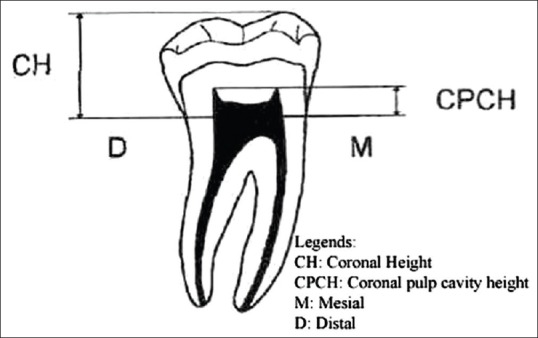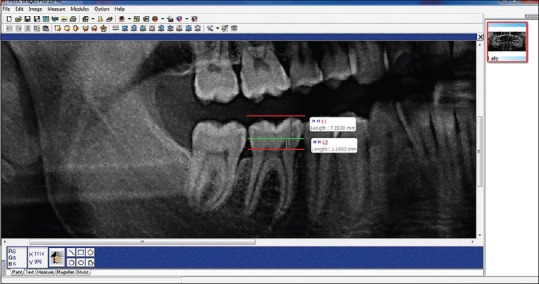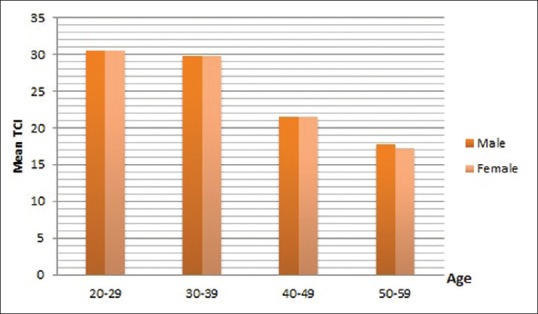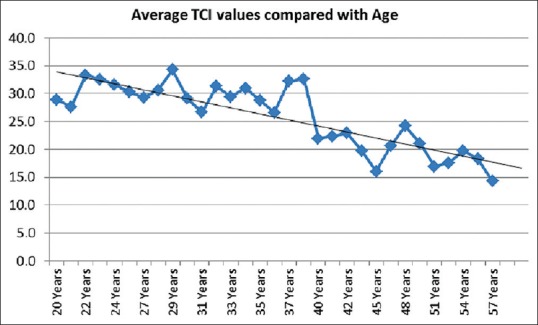Abstract
Objective:
A study was carried out to analyze the efficacy and practical application for age estimation using digital panoramic radiograph to exploit image analysis to obtain metric measurement of morphological parameters of permanent mandibular first molar on Sulaimani population.
Materials and Methods:
In the present study a population of known age and sex was studied and subjected to digital panoramic radiographic examination. The correlation between the reduction of coronal pulp cavity and chronological age was examined in a sample of 96 individuals distributed into four age groups: 20-29 years (29 cases), 30-39 years (29 cases), 40-49 years (26 cases) and 50-59 years (12 cases). The height (mm) of the crown (CH = coronal height) and the height (mm) of coronal pulp cavity (CPCH = coronal pulp cavity height) of 96 of first molars from all subjects was measured. The tooth–coronal index (TCI) after Ikeda et al. was computed for each tooth and regressed on real age.
Results:
ANOVA was used to show the strength of relation between the age and TCI (P = 0.0000). The correlation coefficient (r2) was 0.49, which mean there is strong negative linear regression between age and TCI with the r2, regarding predicting age using TCI value, after the following equation calculated, Predicted age = 3.78 – (0.064 TCI) showed that there is no significant difference between real age and estimated age.
Conclusion:
There is a strong negative liner relationship between TCIs of mandibular first molars with chronological age of Sulaimani population, and age of individuals can therefore be estimated with a good degree of accuracy using regression equations.
Keywords: Computer-based image analysis, coronal height, coronal pulp cavity height, forensic dentistry, tooth–coronal index
Introduction
Forensic identification includes processing long bones and teeth in order to verify a person's age. Whereas both bones and teeth can be used in postmortem, teeth can also be inspected to some degree during life.[1]
Several authors have reported different techniques for dental age calculation in the forensic literature. Among those are morphological and radiological techniques. Most commonly used morphological techniques are based on the length of the apical translucent zone and on the evaluation of age-related criteria such as attrition, secondary dentin, periodontal attachment, translucent apical zone, cementum apposition and root resorption. Some dental age estimation methods that are frequently used require extraction, and most of the time preparation of microscopic sections of at least one tooth from each individual. These methods cannot be used in living individuals and in cases where it is not acceptable to extract teeth for ethical, religious, cultural, or scientific reasons.[2]
The dental pulp can also be used as an indicator for age as it undergoes a reduction in size, with increasing age due to secondary dentin deposition; since this is a continuous process it can be used as a parameter of age estimation even beyond 25 years of age.[3]
The use of tooth radiographs is a nondestructive and simple process which can be applied to both living and deceased persons, in contrast to other time-consuming, expensive, less reliable and destructive methods that may not be acceptable for ethical, religious, cultural or scientific reasons, procedures such as digitization of panoramic radiographs and computer-assisted image analysis avoid the bias inherent in observer subjectivity and improve reliability, accuracy and precision.[4]
Alternative approaches based on digitalization of panoramic radiographs and their computerized storage has recently become available. These procedures exploit image analysis to obtain nondestructive metric measurements of both pulp chambers and teeth. Forensic odontologists may now utilize these techniques that are relatively precise and accurate. Computer-assisted image analysis avoids the bias inherent in observer subjectivity and improves the reliability and the statistical analysis of data.[5]
This study was carried out to present a method for assessing chronological age based on the relationship between age and measurement of the tooth-coronal index (TCI) on mandibular first molar in an attempt to improve the precision and reliability of age estimations.
Materials and Methods
The study groups ranged from 20 years (240 months) to 60 years (720 months); pantomographs collected from patients were taken as a part of the routine treatment that is being rendered to the patient of both sexes.
Inclusion criteria
Pantomographs selected were of the patients aged between 20 and 60 years
The selected tooth on the orthopantomograph, permanent mandibular first molar
The obtained panoramic radiographs showing good morphological features of the study teeth are assessed for coronal pulp index (CPI).
Exclusion criteria
Tooth with any pathology such as caries, periodontitis and periapical lesion that alter the surface area of tooth
Filled tooth or any prosthetic crown
Root-filled tooth
Badly rotated or enamel overlap.
A panoramic radiographic of permanent first molar of any one side was conducted on the selected individuals. The TCI is calibrated with the computer software for accuracy and precision. The values obtained were then subjected to regression analysis to derive equations for age estimation. The results were calculated and correlated with the chronologic age for evaluation.
Morphometric analysis
One of the features of the software is that it allows linear as well as curvilinear measurements between any two points or multiple points.
A straight line traced between the cemento-enamel junctions is the division between the anatomical crown and root. The crown height (CH) was measured vertically from the cervical line to the tip of the highest cusp following Moss et al.,[6] and the coronal pulp cavity height (CPCH) was measured vertically from the cervical line to the tip of the highest pulp horn after Ikeda et al., [Figures 1 and 2]. This measurement provided the TCI for each tooth which was then calculated as follows: TCI = CPCH *100/CH.
Figure 1.

Schematic representation of measurements taken off a panoramic radiograph with a digital caliper to 0.01 mm
Figure 2.

The method of calculation for crown height (CH) and coronal pulp cavity height (CPCH) of a molar tooth
The measurements displayed in millimeters along with the image. The measurements made were stored along with the captured image for further identification and reference. The data obtained, using the materials and methodology described above, was arranged in tables, sorted and analyzed statistically to enable discussion and conclusions.
Statistical methods
Pearson correlation co-efficient has been used to find the significance relationship between age and TCI. A prediction equation for predicting the age using the TCI for molar was calculated using regression analysis.
Results
A correlation study consisting of 96 subjects is undertaken to study the degree of relationship between age and TCI in molars as well as the establishing the prediction equation for predicting the age based on TCI.
The mean of coronal height (CH), CPCH and mean of TCI and standard deviation for all groups are shown in Table 1.
Table 1.
Comparison of coronal height, coronal pulp cavity height and tooth-coronal index in male and female subjects in different age groups (results are presented in mean and standard deviation)

The correlation of male and female for all sample groups to mean of TCI is shown in Figure 3.
Figure 3.

Relationship between volume ratio of the pulp chamber and age in each sex
ANOVA was used to show the strength of relation between the age and TCI (P = 0.0000), which means there is a strong relation between the two parameters age and TCI.
The correlation coefficient (r2) was 0.49, which means there is strong negative linear regression between age and TCI with r2, which mean 49% of the difference in the TCI of the sample can be explained by the change in the age, by other words increase in age, will lead to decrease in TCI value [Figure 4].
Figure 4.

Comparison of the tooth–coronal index in different age groups
The statistical analysis for the whole sample done by ANOVA and coefficient of relation r2 is shown in Table 2.
Table 2.
ANOVA test and coefficient of relation r2

To predict age using TCI value, the following equation is calculated:
Predicted age = 3.78 – (0.064 TCI)
So for the whole sample, the real age and the predicted age using TCI values were similar. The mean of the real age is 35.79, and the mean of the predicted age is 35.89, which mean that the equation calculated is very useful for predicting age using the TCI as this study is a forensic study and calculation of the age is the mail goal, and the numbers are explained in Table 3 and Figure 5. For instance, if a cadaver is found with teeth, in this case taking a radiograph is enough to calculate the age of the cadaver by the equation calculated in this study.
Table 3.
The predicted age compared to the real age for each age groups

Figure 5.

The predicted age and the real age for the whole sample
Discussion
Forensic odontologists are often confronted with the problem of determining the age of unknown bodies, as well as for living persons.[7] Dental maturity has played an important role in estimating chronological age of individuals because of low variability of dental indicators reported.[8]
Examination of the pulp space offers new opportunities in dental age identification. A commonly used method found to be effective is the evaluation of secondary dentine apposition. This apposition is a continuous, age-associated process, which alters the size of the pulp chamber and is only modified under pathological conditions (e.g. caries). Various methods have been developed to study the size of the pulp chamber, including tooth cross sections and radiographs.[9]
The secondary dentine deposition is indirectly measured by measuring the reduction of the pulp chamber. It is reported that secondary dentine deposition is not homogeneously spread all over the pulp cavity. In molars as the age advances secondary dentine deposition occurs preferentially on the roof and floor of the pulp chamber reducing the height rather than width of the pulp chamber.[10]
In our study, we have used digital orthopantomographs for assessment of age because of possibility of evaluation of all teeth along with the alveolar bone in both jaws; several measurements can be performed on the same x-ray. Furthermore, orthopantomograph is a standard technique with high reproducibility, with the acceptability of intraoral radiograph being dependent on the techniques used and the practical training of the personnel.[3] Alternative approaches based on digitalization of panoramic radiographs and their computerized storage have recently become available. These procedures exploit image analysis to obtain nondestructive metric measurements of both pulp chambers and teeth, which can be used to assess the age of an individual.[11]
The present study for adult age estimation was conducted using panoramic radiographs. The panoramic technique has the advantage of displaying all the mandibular and maxillary teeth on a single film. The teeth included in the present study were mandibular first molar in which the pulp chamber had good delineation and the chronological age with morphometric values of pulp on digital panoramic radiographs for the mandibular first molar were assessed and this was accomplished by determining the ratio of height of coronal pulp to that of the CH.
The present study shows a significant correlation of the TCI of the coronal pulp cavity with advancing chronological age in accordance with the studies conducted by Drusini, Igbigbi and Nyirenda and Veera.
Significant negative correlation[12] was demonstrated by Drusini, 2008 between TCI and age of 846 intact premolar and molar from 433 individuals of known age and sex using panoramic radiograph and the TCI after Ikeda et al.[13] computed for each tooth and regressed on the real age of the sample.
Igbigbi and Nyirenda[14] also found higher degree of correlation between age and TCI of premolar and molar in 134 adult Malawians from panoramic radiograph and the TCIs were computed for each tooth and regressed on real age.
Veera[15] demonstrated that prediction potential of TCI for predicting the age comes down for the age group above 50 years in both premolar and molar. Also, the prediction of age based on TCI is comfortably good in ages below 50 years and there is significant relationship between TCI and age after the correlation between the reduction of coronal pulp cavity and chronological age was examined of 100 premolar and 100 molars from 50 males and 50 female subjects.
The present study showed that the coefficients of correlation between actual age and predicted age were found to be very significantly high for first molars similar to those of Ikeda et al.[13] and came in accordance with studies of Drusini, Igbigbi and Nyirenda, and Veera;[12,14,15] also the present study showed a significantly near accurate age estimation compared to the other studies.[10,11,16]
A significant strong correlation was found between chronological age and pulp chamber crown root trunk height ratio and no significant difference was found between the actual age and calculated age[10] as concluded by Mathew et al.; in a orthopantomography (OPG) study of 88 subjects mandibular first molar were digitalized using scanner (Umax™).
No significant difference between estimated age and chronological age[11] was demonstrated by Singaraju and Sharada in a study of 200 rotational pantomographs, and radiographic images of the canine were then processed using computer-aided program AutoCAD 2000 to assess age estimation using the pulp/tooth area ratio.
Cameriere et al.[16] showed that pulp/tooth area ratio is a useful variable for assessing age with reasonable accuracy after analysis of 606 OPG using lower premolar.
Conclusion
In the present study it is noted that the correlation of age with TCI in different age groups is significantly very high using permanent lower molar. Hence, it can be concluded that the TCI can be good predictors of age.
Further studies are needed based on larger sample size, with other teeth as biomarkers, covering a large geographic area, taking into account different environmental factors such as dietary habits, genetic background, and history of any illness or that of the present one of disease-related dentition to know their effect on the accuracy of age prediction.
The potential of the TCI index using digital panoramic could prove useful as a biomarker of aging. Increasing availability of digital radiographic system in dental institutes and offices and a good accuracy of the method may also make such a method of age estimation widely available, cost effective, scientific and invaluable in the fields of dentistry, forensic and anthropology as well.
Footnotes
Source of Support: Nil
Conflict of Interest: None declared
References
- 1.Saxena S. Age estimation of Indian adults from orthopantomographs. Braz Oral Res. 2011;25:225–9. doi: 10.1590/s1806-83242011005000009. [DOI] [PubMed] [Google Scholar]
- 2.Bosmans N, Ann P, Aly M, Willems G. The application of Kvaal's dental age calculation technique on panoramic dental radiographs. Forensic Sci Int. 2005;153:208–12. doi: 10.1016/j.forsciint.2004.08.017. [DOI] [PubMed] [Google Scholar]
- 3.Chandramala R. Application of Kvaal's Technique of Age Estimation on Digital Panoramic Radiographs. Bangalore, Karnataka: Rajiv Gandhi University of Health Sciences; 2009. p. 2. [Google Scholar]
- 4.Vandevoort FM, Bergmans L, Van Cleynenbreugel J, Bielen DJ, Lambrechts P, Wevers M, et al. Age calculation using X-ray microfocus computed tomographical scanning of teeth: A pilot study. J Forensic Sci. 2004;49:787–90. [PubMed] [Google Scholar]
- 5.Cameriere R, Ferrante L, Cingolani M. Variations in pulp/tooth area ratio as an indicator of age: A preliminary study. J Forensic Sci. 2004;49:317–9. [PubMed] [Google Scholar]
- 6.Moss ML, Chase PS, Hower BI., Jr Comparative odontometry of the permanent post canine dentition of American Whites and Negroes. Am J Phys Anthropol. 1967;27:125–42. [Google Scholar]
- 7.Stavrianos CH, Mastagas D, Stavrianou I, Karaiskou O. Dental age estimation of adults: A review of methods and principles. Res J Med Sci. 2008;2:258–68. [Google Scholar]
- 8.Willems G. A review of most commonly used dental age estimation techniques. J Forensic Odontostomatol. 2001;19:9–17. [PubMed] [Google Scholar]
- 9.Jagannathan N, Neelakantan P, Thiruvengadam C, Ramani P, Premkumar P, Natesan A, et al. Age estimation in an Indian population using pulp/tooth volume ratio of mandibular canines obtained from cone beam computed tomography. J Forensic Odontostomatol. 2011;29:1–6. [PMC free article] [PubMed] [Google Scholar]
- 10.Mathew DG, Rajesh S, Koshi E, Priya LE, Nair AS, Mohan A. Adult forensic age estimation using mandibular first molar radiographs: A novel technique. J Forensic Dent Sci. 2013;5:56–9. doi: 10.4103/0975-1475.114552. [DOI] [PMC free article] [PubMed] [Google Scholar]
- 11.Singaraju S, Sharada P. Age estimation using pulp/tooth area ratio: A digital image analysis. J Forensic Dent Sci. 2009;1:37–41. [Google Scholar]
- 12.Drusini AG. The coronal pulp cavity index: A forensic tool for age determination in human adults. Cuad Med Forense. 2008;14:235–49. [Google Scholar]
- 13.Ikeda N, Umetsu K, Kashimura S, Suzuki T, Oumi M. Estimation of age from teeth with their soft X-ray finding. Nihon Hoigaku Zasshi. 1985;39:244–50. [PubMed] [Google Scholar]
- 14.Igbigbi PS, Nyirenda SK. Age estimation of Malawian adults form dental radiographs. West Afr J Med. 2005;24:329–33. doi: 10.4314/wajm.v24i4.28227. [DOI] [PubMed] [Google Scholar]
- 15.Veera SD. Morphometric Analysis of Pulp Chamber as a Method of Age Estimation Using Panoramic Radiographs. Bangalore Karnataka: Rajiv Gandhi University of Health Sciences; 2008. p. 57. [Google Scholar]
- 16.Cameriere R, De Luca S, Alemán I, Ferrante L, Cingolani M. Age estimation by pulp/tooth ratio in lower premolars by orthopantomography. Forensic Sci Int. 2012;214:105–12. doi: 10.1016/j.forsciint.2011.07.028. [DOI] [PubMed] [Google Scholar]


